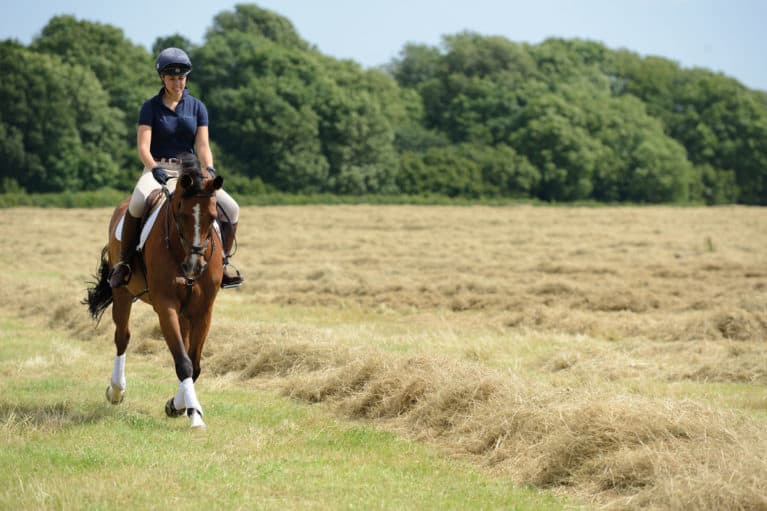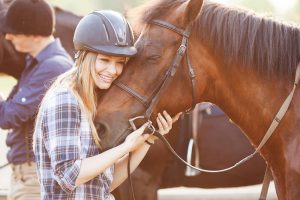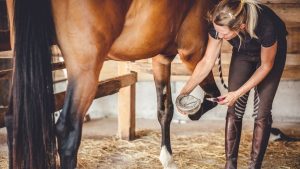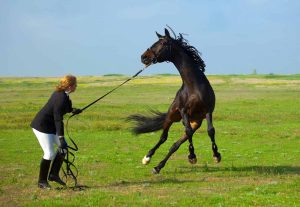The care and attention that a horse receives from its owner or handler is reflected in its health. Exercise is an important part of a horse’s health because it keeps your horse’s body healthy and his mind sharp. Horses that perform a variety of exercises stay healthy, avoid accidents and have better overall training results. Whether you’re training for a competition or just want to ensure your horse lives a happy and healthy life, it’s important to perform a range of exercises. This book shows you six good exercise routines for horses, each designed to target a different area of development.
1. Longeing for Warm-Up and Conditioning:
A horse circles its owner along a long rope. This is called a lunge or lunge. This is a great way to prepare your horse for more intense training, as it allows the horse to stretch its legs and build muscle without anyone sitting on top. Distance running can also be used to keep horses in shape, especially those that are recovering from an accident or just starting to learn how to do it. It helps the horse improve balance and endurance, and it allows the trainer to observe how the horse moves and correct any problems he notices.
2. Dressage Training Makes You More Flexible and Self-Disciplined:
Dressage exercises are intended to strengthen the horse’s natural athleticism and willingness to work. These habits help the horse become more disciplined by focusing on accuracy, agility and obedience. Simple dressage movements such as the leg-in, the shoulder-in and the serpentine can make the horse more agile, teach it to pay attention to small cues and strengthen the bond between rider and horse.
3. Cycling Builds Endurance and Keeps Your Mind Sharp:
Off-roading isn’t just for fun; it’s also a great way to strengthen your horse’s body and keep their mind sharp. Leading your horse through different areas and terrain is beneficial to his health, as it builds muscle strength and heart health. It also keeps your horse’s mind active and prevents him from becoming bored and mischievous. Trail riding makes horses more alert and sensitive, which are important skills in all disciplines.
4. Jumping Exercises to Increase Speed and Strength:
Incorporating jumping movements into your horse’s training routine will help him become faster, stronger and better coordinated. A horse’s confidence and ability to climb obstacles can be built by starting with lower obstacles and eventually adding higher heights and complexity. It is important to ensure that your horse is properly warmed up before jumping to avoid injuries. These exercises are good for all horses, not just jumping, because they make the horse stronger and more agile.
5. Work with the Pole to Improve Concentration and Coordination:
When horses train with poles, they walk, trot or jog on a set of ground or elevated poles. This exercise is great for improving footwork, coordination and concentration. It teaches the horse how to change speed and maneuver carefully around obstacles. Pole training is also good for the rider because it requires time and rhythm to guide the horse properly. Anyone at any skill level, from beginners to seasoned athletes, can perform this workout.
6. Hill Training can Make Horse Stronger and Build Muscle:
Hill training is a great way to strengthen horses muscles, especially their back muscles, and improve their cardiorespiratory fitness. Horses need to use their hind legs to build strength and endurance. Walking or jogging up and down hills can help with this. In addition, this exercise makes you more balanced and stable, which is important in all equestrian sports. To prevent your horse from becoming tired and stressed, make sure he is in good condition for heavy work.
Summary:
A variety of exercises are important to keep your horse healthy, happy and performing well. You can stimulate your horse’s growth in different areas by giving him different exercises, such as distance running, dressage, trail riding, jumping, pole training and hill training. When planning your horse’s exercise routine, you should always take his specific needs and health into account. If necessary, you can consult a veterinarian or an equine fitness trainer. By being patient, consistent and providing the right exercises, you can ensure that your horse performs well both in competition and in everyday life.
FAQs:
1. Why is it important to train your horse in different ways?
Practicing a variety of exercises is essential for your horse’s physical and mental health. It prevents boredom, reduces the risk of injuries by not overusing certain muscles and ensures the overall health of the horse. Different training programs can also cater to specific training goals and meet the individual needs of the horse based on its discipline, age and fitness level.
2. How often should I train my horse to keep him in good condition?
Training frequency should be adjusted based on the horse’s current condition, age and the requirements of the sport in which he is involved. In general, horses should be exercised 5–6 days per week for optimal health. However, the intensity and duration of these sessions can vary. It is important to allow rest days to allow recovery and to monitor your horse for signs of fatigue or overtraining.
3. Can I practice these sports with a young horse?
Yes, but with adjustments and considerations based on their age and development. Young horses’ bones and joints are developing, so their daily training should focus on low-intensity exercises and gradually increase in intensity. It is necessary to consult a veterinarian or equine exercise expert to design an appropriate program to support healthy growth.
4. What should I do if my horse shows signs of boredom or disinterest in daily exercise?
If your horse seems bored or disinterested, it may be time to introduce new exercises or change his routine. This may include changing the environment of the sport by incorporating ground training or agility training, or even taking a break to participate in more casual activities such as trail riding. Keeping the lessons varied and interesting will keep your horse interested and motivated.
5. Is there a best time of day to train a horse?
The best time to train your horse depends on several factors, including the weather, your horse’s feeding schedule and your available time. Many people prefer to exercise their horses in the morning when temperatures are cooler, especially in warm climates. However, making sure your horse is properly warmed up and not exercising immediately after eating is more important than the time of day. Listen to your horse and adjust your schedule as necessary to meet his natural rhythms and preferences.



